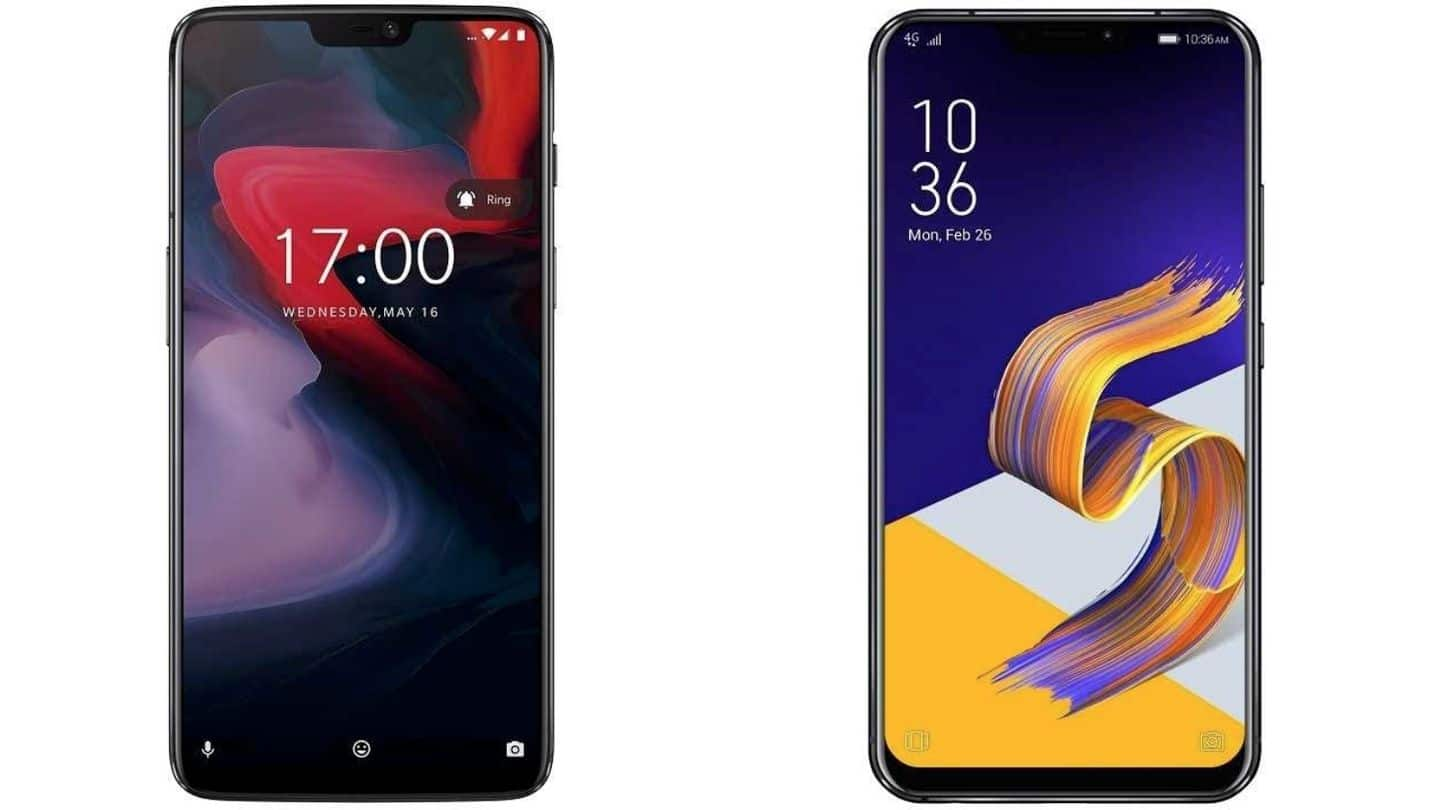
#SmartphonesFaceoff: ASUS ZenFone 5Z vs OnePlus 6
What's the story
In days from now, on July 4, ASUS will launch its 2018 flagship smartphone, the ASUS Zenfone 5Z. The phone is being touted to "redefine" flagships and is expected to take on the likes of OnePlus 6 and Honor 10. Hence, in our today's smartphones face-off, we pit against each other the two contenders, Zenfone 5Z, and the reigning flagship killer, OnePlus 6.
Information
ASUS ZenFone 5Z will be priced somewhere around Rs. 30,000
While ASUS hasn't revealed the pricing for ZenFone 5Z, it is expected to take on the likes of OnePlus 6 and Honor 10 in the mid-premium price segment. The Honor 10 costs Rs. 32,999 (6GB RAM/128GB) while the OnePlus 6 starts at Rs. 34,999 (6GB/64GB).
Design
At a glance
Up front, both phones look quite identical with their smaller iPhone X-like notched displays, curved corners, an edge-to-edge display and a smaller bottom bezel rounding-off the look. However, the back panel is what differentiates the two flagships. The ZenFone 5Z gets a shimmery metallic back-panel whereas OnePlus 6 offers a refined, premium-looking Gorilla Glass 5 back. Here, OnePlus 6 won't fail to impress.
Display
All about the screen
The ZenFone 5Z offers a 6.2-inches Super IPS+LCD display with a resolution of 1080x2246 pixels, 18.7:9 aspect ratio and a pixel density of 402ppi. The OnePlus 6 has a slightly taller 6.3-inches AMOLED display with a resolution of 1080x2280 pixels, 19:9 aspect ratio and a pixel density of 402ppi. The difference isn't significant but OnePlus 6 offers deeper blacks, thanks to its AMOLED display.
Primary Camera
For the shutterbugs
The ASUS Zenfone 5Z sports a vertically aligned rear dual-camera setup featuring a 12MP+8MP and supports 720p recording at 240fps. OnePlus 6 also gets a dual-rear camera setup featuring 20MP+16MP sensors with OIS and EIS, and supports 720p slow-mo recording at 480fps. Again, the OnePlus 6 offers slightly sharper pictures, better slow-mo video recording, and a bit more refined Portrait photography.
Selfie Camera
For the love of Selfies
On the front panel, the ZenFone 5Z gets an 8MP f/2.0 selfie shooter with a wide-angle lens, autofocus, HDR, 3-axis EIS and real-time beautification features. The OnePlus 6 sports a 16MP f/2.0 sensor with EIS and AI-based Portrait photography. In this case too, OnePlus 6 has an upper hand. The flagship offers sharper selfies and the Bokeh effect is pretty accurate.
Internals
All the important stuff
Under the hood, the ZenFone 5Z gets a Qualcomm Snapdragon 845 chipset with Artificial Intelligence Engine, up to 8GB RAM and up to 256GB storage (expandable up to 2TB). OnePlus 6 is powered by a Qualcomm Snapdragon 845 processor with up to 8GB RAM and up to 256GB storage (non-expandable). The ASUS takes its first point here for the AI engine and expandable storage.
Sensors & Software
Lifeblood of your smartphone
Both phones come with standard sensors including an accelerometer, ambient light sensor, digital compass, gyroscope, proximity sensor and rear-mounted fingerprint sensor. In terms of software, the ZenFone 5Z runs Android 8.0 Oreo-based ZenUI 5.0 whereas OnePlus 6 runs Android 8.1 Oreo-based OxygenOS 5.1 and will be one of the first few phones to get Android P update. OnePlus 6 is an easy pick again.
Battery & Connectivity
Staying connected
Both flagships come with similar connectivity options including VoLTE, Bluetooth 5.0, USB Type-C port and headphone jack. Notably, the two phones also pack same 3,300mAh batteries. However, apart from standard fast-charging, ASUS offers 'AI Charging' for efficient charging while OnePlus 6 comes with Dash Charge which gives "a day's power in half an hour." On this aspect, it looks like a tie.
Our result
How things stack up: Final verdict
While ZenFone 5Z may be looking to "redefine" flagship smartphones with top-end specs and AI-based features, it needs to check all the boxes, especially the price point at which it enters the Indian market. On the other hand, OnePlus 6 continues to be an easy pick for its top-end specs, better camera, near stock Android OS and timely updates. Our winner is OnePlus 6.